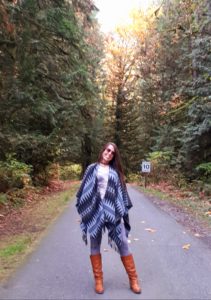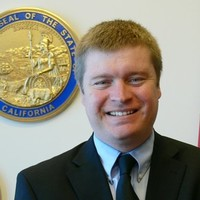Tag: SI Alum Spotlight
OHC Advanced Oral History Alum Spotlight: Meagan Gough
by Shanna Farrell
@shanna_farrell
Meagan Gough attended the Oral History Center’s Advanced Summer Institute in August 2017. We recently caught up with her to see how her time with us helped her develop her project around the Semá:th First Nation in British Columbia, who an indigenous to Canada.

Q: You attended the Summer Institute in 2017. What were you working on when you joined us?
MG: The Semá:th Traditional Use and Occupancy Project (“TUOS”) invited the participation of Semá:th community members from the Semá:th First Nation in British Columbia, Canada to document their connection to, and care-taking responsibilities over, natural and cultural resources within Semá:th traditional Territory and beyond. The TUOS project combines oral history interviews, GIS Mapping historical research and community engagement and events to accomplish the following goals:
- To record and map how access, use and occupancy of important cultural and natural resources is determined and understood by a diverse group of Semá:th Knowledge Holders made up of men, women, Elders, youth, political and spiritual leadership.
- To add layers to the existing historical record about Semá:th culture, history and identity through the transmission of two main types of Semá:th oral history: Sqwélqwel (genealogy or “true news”) and sxwōxwiyám (stories of long ago, origin stories).
- Engage Semá:th Knowledge holders in vision for future caretaking of land, water and air to reflect Semá:th history, culture and protocol.
- Assert Semá:th Right and Title through policy and practice, including Specific Land Claims.
- Celebrate and promote Semá:th cultural identity, knowledge
- Strengthen the capacity of the Semá:th Lands & Resources Department to respond to development referrals in Semá:th Territory.
- Draw upon community input to create and support opportunities for lands-based activities and programs in the community.
- Support seeking solutions to the mental health and suicide crisis in community using lands-based teaching and oral history.
Q: How did your time at the Summer Institute inform your project?
MG: Participation in the Advanced Institute provides a unique opportunity for general learning, reflection and engagement with oral history methods, practices and projects but also to workshop our own individual projects. This allowed us as participants to move between the macro and big picture methods, debates and teachings of oral history which inform our work and the practical individual application of this knowledge into practice in our own projects.
I found this to be a deeply enriching experience, particularly because my small group was comprised of scholars and researchers from diverse disciplines. As a scholar who draws simultaneously from disciplines of cultural anthropology, history and oral history, the input provided to me about my project during our small group presentation was extremely helpful and came into practical use since. Given the central importance of oral record in the Semá:th community, I came to the Advanced Institute with questions about ideas of how to engage community youth and elders using oral history interviews and storytelling to draw upon this record.
One suggestion was an Elder-Youth storytelling circle. A version of this became one of the central activities in Phase 3 of our project. Our Elder-Youth Storytelling event invited Elders and Youth to take turns in the roles of speaker and listener: We matched Youth and Elders and first the Elders shared lands based knowledge and oral history. The youth then had a two week period to reflect upon and interpret this oral history and present it back to the Elders and the group via a medium of their choice: writing, poetry, spoken word, song, dance, performance, and visual arts were all encouraged. The Elders then assumed the roles of listener. The circle had multiple goals: to fortify relations between Elders and Youth, to provide a unique opportunity for the transmission of traditional and historical cultural knowledge, and to encourage the exploration of the dialogical elements of such an exchange. How did the youth interpret the stories? Did the speakers feel their stories were understood as they intended them? The Youths’ art projects are currently displayed in the Semá:th Band office.
The second primary way that participation in the Institute informed our project was the inspiration I took from some of our key presenters, especially the Oakland Chinese Community Oral history project. This is where I learned about the concept of a Storymap – a digital multimedia platform to preserve and present community maps. In 2018 and Phase 3 of TUOS project, we commenced the creation of our own Storymap. Through the use of oral histories and photographs shared via TUOS interviews with Semá:th Knowledge Holders, the Semá:th Genealogy Mapping Storymap was aimed at using geneology to map the movement of ancestors of the Semá:th First Nation.
Q: What is the status of the Semá:th Traditional Use Study now?
MG: We have received successful funding from BCCI our funding agency, and commenced Phase 4 of the TUOS project. To date, we have recorded over 25 oral history interviews with Semá:th Knowledge Holders, as well mapped over 500 traditional use sites. We have created a database to archive and preserve this information so it may be used by Lands Department staff to respond to the overwhelming number of referrals from government and industry involving Semá:th Lands. We have also conducted historical and archival research and created a Semá:th historical photo collection, also housed in the database. We have hosted a number of community events which sought to seek input from Knowledge Holders as well as to keep them informed about the status of the project.
Q: You’ve described the Summer Institute having ripple effects on your work. Can you tell us more about this?
MG: My participation in the Advanced Institute was, without exaggeration, by far the most enriching professional experience I have had in terms of a course or workshop. Having practiced oral history interviewing for over 15 years, I came away generally feeling inspired, refreshed and also extremely appreciative of having my practical workshop questions answered. I was able to continue to build upon the input of my small group colleagues to integrate it into our project. I made professional contacts from around the world, some of whom have gone on to become friends. The ability to workshop our projects with a small group truly allows a deep insight into the workings of other oral history projects and by virtue of listening how technical, ethical and practical elements are addressed and resolved. The ripples of my participation are evident in tangible form via the practical application of my learning at the Institute into the creation of the Storymap as well as our Elder-Youth Storytelling Circle Event.
Q: What’s next for the project? What’s next for you?
MG: We are currently in Phase 4 of our project, we are building another “layer” of our Storymap this year which maps how traditional caretaking responsibilities extend far beyond the borders of reserve (reservation) lands across the Province, country and Internationally into the United States. We are also contributing chapters to a forthcoming publication exploring hidden histories of British Columbia. (Working title, stay tuned!) The interviews are being used in a number of capacities, asserting Right and Title to Lands, including specific land claims, on reserve lands based policy, negotiation with industry and Government.
For myself, I have just become a first time mom, so life is busy and I am full of joy and gratitude. As I write this now, I consider it a dispatch from “babyland” a unique space of the spirit and one which provides a new lens on everything in life. I hope to share the beauty and power of listening, of stories and of learning with my baby as she grows. I would like to take this opportunity to thank the Berkeley Institute and all those whose hard work make it come to fruition. “All things Flow, Nothing Stands Still” – there is always something more to learn, another story to listen to, another perspective to understand. Oral history is endlessly inspiring!
Summer Institute Alumni Spotlight: Alex Vassar
As interviewed by Todd Holmes

Alex Vassar attend our Advanced Oral History Summer Institute in 2017. A seasoned civil servant, Alex is no stranger to the circles of California government. In 2007, he served as a Senate Fellow in the state’s upper house, and worked thereafter in both houses before transferring to other departments of state government. Currently, he is the Communications Manager of the California State Library. When he joined us last summer, he had just finished an oral history of former State Senator Denise Ducheny on behalf of the State Archives. This interview was part of a collaborative effort between the State Archives, State Library, Sacramento State, and UC Berkeley’s Oral History Center to revamp the California State Government Oral History Program. That long effort ultimately proved successful, as the program was refunded in the 2018-19 state budget. We caught up with Alex this past month at his office in Sacramento to this victory and see what else he’s been up to since last summer.
Q: Tell us a little bit about your work and how you use oral history.
Vassar: I have always been interested in the political process and how the experiences of the people who run for office impact their thinking and decisions. That was a large part of why I moved to Sacramento in 2007 to participate in the Senate Fellows Program at Sacramento State. In the years since, I have conducted a number of short interviews with current and former state legislators. These interviews formed the crux of my recent book, California Lawmaker: The Men and Women of the California Legislature.
In 2016, I had the opportunity to sit down with former State Senator Denise Moreno Ducheny for a 14-hour interview. This was part of the State Government Oral History Program, housed at the California State Archives since the 1980s. I loved the long format of the oral history interview, spaced between multiple sessions, and how it allowed the interviewee to tell stories and take the time to explore memories.
Q: How did the Summer Institute shape your work?
Vassar: In 2017, I accepted a new role at the California State Library, heading up the Communications Division. Almost immediately after starting the new job, I had the opportunity to participate in the Oral History Center’s Advanced Summer Institute, thanks to the support of State Librarian Greg Lucas. It was an amazing experience and I loved the speakers, my classmates, and the campus. (My mother was working on a Ph.D. at Cal when I was born, but I had never spent more than a few hours on campus.) The Summer Institute gave me new insight into the practice of oral history, knowledge I’m hoping to bring to new interviews in the future, and more importantly, to the oral history-based initiatives we have created at the State Library.
Q: Tell us about these initiatives and what’s next on the horizon for your work in oral history?
Vassar: Recently, I’ve worked with State Librarian Greg Lucas and State Archivist Nancy Lenoil, as well as institutional partners such as the UC Berkeley’s Oral History Center and the Center for California Studies at Sacramento State, to restart the State Government Oral History Program. Created in the 1980s, the program had conducted hundreds of oral history interviews with former lawmakers and civil servants before funding was cut in 2003. My interview with Senator Ducheny was one of the few interviews conducted in recent years, thanks to the Center for California Studies at Sacramento State. I’m happy to report, however, that the efforts of the OHC and Sacramento State proved successful, with refunding of the State Government Oral History Program in the 2018-19 California budget. In addition to this program, we are also currently meeting with academic institutions to establish resources for oral historians to use and share at the State Library.